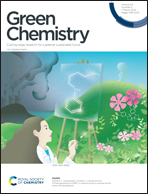Ecotoxicological risk assessment of organic compounds against various aquatic and terrestrial species: application of interspecies i-QSTTR and species sensitivity distribution techniques†
Abstract
Organic chemicals (OCs) constitute a large proportion of the output of chemical and allied industries in the form of pharmaceuticals, cosmetics, agrochemicals, biocides, etc. demonstrating very high structural heterogeneity and their continuous detection in aquatic compartments, which have raised ecological concerns. In silico techniques employed in hazard assessment have evolved for years starting from simple quantitative structure–activity/toxicity relationship (QSAR/QSTR) models to interspecies quantitative structure–toxicity–toxicity relationship (i-QSTTR) models and finally towards species sensitivity distributions (SSDs). These techniques have gradually offered more and more known levels of uncertainty in the predictions derived from them. The current manuscript reports sufficiently robust and externally predictive interspecies i-QSTTR and SSD derived models employing ecotoxicity data of organic chemicals against 10 different groups of species compiled from the ECOTOX database. The models were developed using simple and interpretable 2D descriptors and employing the partial least squares (PLS) regression technique in most cases. The methodology including dataset preparation/division, model development/validation, applicability domain (AD) assessment, and interpretation was implemented conforming to the OECD protocols for QSAR model development. Mean (μ), standard deviation (ρ), and difference (δ) models were employed for deriving SSDs of compounds not having experimental data against at least three groups of species. Moreover, the prediction reliability indicator (PRI) tool (http://teqip.jdvu.ac.in/QSAR_Tools/) was used to check the reliability of predicted SSDs for the extended list of modeled compounds. The results demonstrate the advantages of SSD-derived models in ecotoxicity predictions over other in silico techniques.



 Please wait while we load your content...
Please wait while we load your content...